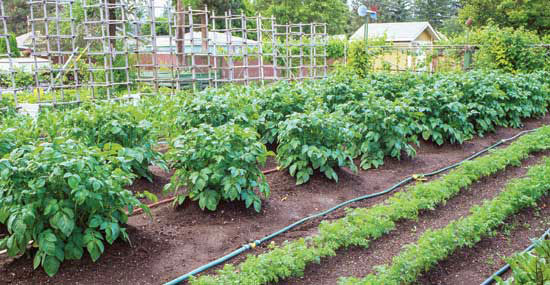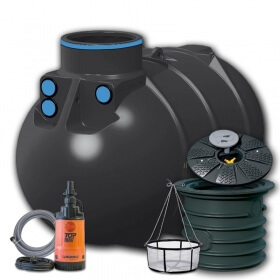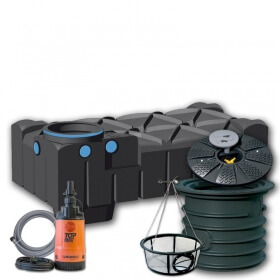- favorite 10 likes
- remove_red_eye 75675 views
- comment 2 comments

How to design a garden irrigation with rainwater?

Maintaining a beautiful, well-kept and green garden, especially during prolonged periods of drought, requires a lot of effort. Difficult conditions, water shortage and lack of shade are a big challenge in maintaining a garden. High temperatures and periods without rainfall for several weeks have a deadly effect on flowering plants, as well as trees and shrubs. Maintaining a garden is difficult. The soil and pots heat up above all norms, and the plants burn. Abundant irrigation is especially important during this period. Due to its properties, rainwater has a very beneficial effect on plants, because it is soft, has a low pH, is rich in nutrients, and is chlorine-free. So why discharge rainwater to the sewage system when you can collect it and use it to care for your own garden while saving money?
Selection of the tank capacity
The basis of the system is the tank. The choice of tank size is a key consideration in system design. Too small its volume may result in insufficient water supply for the intended purposes, while a too large reservoir may result in a long period of water retention in it, which will negatively affect its quality. The reservoir is always selected individually, taking into account the amount of rainfall, the size and type of the catchment area, and the efficiency of filtering devices.

Two values should be compared with each other:
Water yield - this is the amount of water that can be collected, which is a result of the amount of rainfall, the surface from which rainfall will be collected, roofing and the filtering efficiency. We get the value in liters.
V = H · A · s · f [l]

Where:
H - precipitation height [m2],
A - roof area in the horizontal projection [m2]
s - runoff coefficient,
f - filter efficiency.
Consumption of water
There is no point in storing water that cannot be used. The actual consumption depends on the area of the garden, the type of planting, whether we will use rainwater to clean the garage, windows, and car washing.
The average norms of water consumption for watering home gardens and agricultural crops are:
Description | Average norms of water consumption l / m2 per day |
Home garden, recreational plot | 2,5 |
It is assumed that, on average, crops are watered within: 15 days / month in the period from April 15 to September 15.
However, it can be assumed that a 10-centimeter layer of sandy soil can hold 5-7 liters / m2 of water, while heavy soil - from 12-15 liters / m2. Therefore, the following should be used as a guide for the maximum size of a single dose:
• for vegetables with a short growing season, 5-7 liters / m2 · day,
• for vegetables with a long growing season 10 liters / m2 · day,
• for tree orchards up to 20 liters / m2 · day.
Please note that shallow, sandy soils have a low water capacity. The use of excessive doses of water will cause unnecessary washing of soluble minerals, especially nitrogen, from the soil and damage to the structure, as well as deteriorating root growth due to lack of oxygen, etc. More frequent and smaller doses of water should be used during the germination and rising of plants, when they have a very shallow root system.
Rainwater tanks are designed so that they can store the stock for a certain number of days without rainfall. The most common period of 21 days. This will keep the water fresh as it will then be in constant motion. The total water requirement of the building should be multiplied by the reserves. The next step is to compare these two values and optimize them. The tank is secured by an emergency overflow. . It is a drainage of excess water after filling the tank into the ground. Its correct execution prevents rainwater from overflowing and empting the tank. The overflow may be absorptive wells, retention and drainage tanks made of boxes. The appropriate capacity of such solutions depends on the type of ground at the investment site and the size of the reservoir.
Permanent access to rainwater can be ensured with a float water refill kit. In case of water deficit, it can be pumped up from the well or connected to the water supply network.
The rainwater management system should also have appropriate filters. The fact that the water from the roofs is relatively clean, but it may contain leaves, twigs or some unusual impurities that would significantly deteriorate the water quality in the tank. The use of filters is especially important when connecting a tank to sprinklers.
There are many filter options to choose from, which can be divided into external, i.e. placed in front of the tank, or internal, i.e. located in the tank. There are collecting filters that work like baskets in which the contaminants settle. In such solutions, the user is obliged to periodically inspect the filter and empty it of impurities or filter sedimentation tanks. These can be sub-gutter solutions (then one filter should be used under each gutter) or collective in front of the tank. There are also flow filters that discharge pollutants, for example, into the sewage system.
Scheduling automatic irrigation
Automatic irrigation systems are increasingly being installed in gardens. Although the installation itself is not cheap, it ensures rational water consumption and its savings on the level of up to 30% compared to classic irrigation with a hose. The system can work at night, requires virtually no maintenance and can be used in any garden, both small and large. How to install it?

The automatic irrigation system can cover the whole garden or part of it. The irrigation system is easier to schedule in undeveloped land. Most often, the garden is divided into sections, operating alternately. Thanks to this, it is possible to select a pump with lower parameters. Different water dosing elements are used to irrigate various types of garden vegetation. Within lawns, static, rotating or pendulum sprinklers are best suited. They do not hinder the mower's work. They are mounted just below the ground.
Momentally, they only slide out under the influence of water pressure. However, you have to be careful not to damage them while aerating the turf.
In the thicket of plants, cheaper non-demountable models are successfully used - rigid perforated pipes protruding above the ground in the form of dropping lines.

In flower beds, rock gardens and vegetable gardens, micro-sprinklers are most often used, which are easy to dismantle for the time of gardening. Their heads are mounted on 30 cm pins. Thanks to special valves, they create a mist. The devices are placed next to the ground, so they are suitable for plants that do not like watering from above. This way of emitting water provides very effective irrigation. Different types of sprinklers can be freely combined with each other. For example, a drip line at the edge of a garden and a rotary sprinkler on the grass in the center.
In order to design automatic irrigation, all elements that could interfere with running the pipeline or watering plants should be marked on the plot map. These are: a house, a driveway, paths, a pond, elements of small architecture, trees, shrubs, flower beds, a lawn and other objects in the garden.
Then the number of sections is determined and the elements of the automatic irrigation system are selected (first of all, the number, location and type of sprinklers, as well as the length and diameter of the pipes). The type of soil and vegetation as well as the water pressure must be taken into account. The location of sprinklers on the ground plan is marked with points, and their ranges are marked with circles (90 °, 180 °, 270 °, 360 °).
Selection of a pump for garden irrigation
Various types of pumps are available. Some are placed on the surface (surfaced), others are placed in a water tank. These are submersible-pressure pumps (including submersible and rainwater tank pumps). The best solution is to use a submersible pump.
Submersible pumps suck water directly from the reservoir. The motor and the pump are lowered below the water level so that it only functions as a pump forcing water. These types of garden irrigation pumps can draw water even when the water table drops more than 7 meters below ground level. Thanks to the corrosion-resistant casing, they can stay immersed in water and convey a suitable hose to sprinklers, nozzles and spray guns or special lances. By using a submersible pump it is easier to automate the entire irrigation process. The method of use is determined by the power and efficiency of the device. It is worth paying attention to the fact if the submersible pump is equipped with a float to switch it off, which protects it against dry running. When selecting a pump, it is necessary to determine the "operating point" of the pump, which is determined by the nominal flow Q (ie the amount of water pumped per time unit) and the total manometric head Hm.
Capacity and head are shown in the performance chart of each pump model. The characteristic curve shows the relationship between lifting height and capacity.
The pump must operate in the range between its minimum and maximum efficiency, ideally when the duty point is close to the peak efficiency point, as this ensures a long pump life and reduces energy consumption. Operation of the garden irrigation pump outside its characteristic curve may damage it, and it certainly significantly shortens the pump life.
Related products
Gama Rainjet garden system
- Rainwater tank with filter, pump, hose, garden box
- Auto pressure pump
- Volume from 1000l to 3500l
Garden set Standard with Blueline II tank
- Complete rainwater tank with pump and filter
- Top Multi Tech 2 submersible pumps
- Tank capacity from 2,600l to 10,000l
Garden set Standard with Ecoline II tank
- Rainwater set with automatic pump and filter and collection in the lid
- Reinforced construction of the Ecoline II rainwater storage tank
- Capacities from 1700l to 10000l
Garden system Standard with F-Line tank
- Rainwater system for the garden
- Top Multi Tech II submersible pump
- Capacities from 1500l to 7500l
Water rain drop garden system
- Complete rainwater management system for watering the garden
- Fully automatic pump
- Tank capacity 2000l, 3000l, 4000l, 5000l
Comments (2)
-
Dzień dobry, Szukam zestawu do automatycznego nawadniania głownie pomidorów ale też roślin na grządkach. Potrzebuję kompletnego zestawu podzielonego na 2 sekcje ( jedna do pomidorow i papryk, a druga do roslin na grządkach; buraki, marchewki, pietruszki itd)z możliwością rozbudowy w przyszłości na trawnik, pompę do podziemnego zbiornika na deszczówkę i cały osprzęt (reduktor cisnienia, filtry, zawory zwrotne, ewentualne sterowniki itd). Czy dostane taki zestaw u Państwa? Nie bardzo się orientuję jakie pompy stosuje się do takich systemów nawadniających, hydrofor czy pompy zanurzeniowe? Dodatkowo z racji iż otrzymałem dotacje z programu Moja Woda, szukam zbiorników naziemnych na wodę (minimum 2m3) oraz innych ciekawych rozwiązań, tak aby zamknąć się w kwocie 6000 tyś zł (łącznie z wyżej wspomnianym systemem nawadniającym. Bardzo proszę o pomoc i ewentualną wycenę. Zależy mi na czasie - do końca czerwca trzeba wykonać montaż. Numer kontaktowy 696857818 Dziękuje :)
-
Dzień dobry Panie Rafale. Dziękujemy za zapytanie i zainteresowanie naszymi produktami. Oczywiście w naszej ofercie znajdzie Pan pompy zarówno zatapialne, jak i naziemne wraz z systemem sterowania do nich. Oprócz tego nasza oferta jest bogata w zbiorniki naziemne na deszczówkę w różnych pojemnościach. Zbiorniki charakteryzują się zróżnicowanym wzornictwem, od bardzo prostych po dekoracyjne o fantazyjnych wzorach, które na pewno dopasują się do ogrodu. W celu otrzymania oferty specjalnie dla Pana, zachęcamy, aby zgłosić się mailowo: kontakt@aquatechnika.com.pl. Tam również nasi doradcy odpowiedzą na wszystkie Pana pytania. Zapraszamy!





